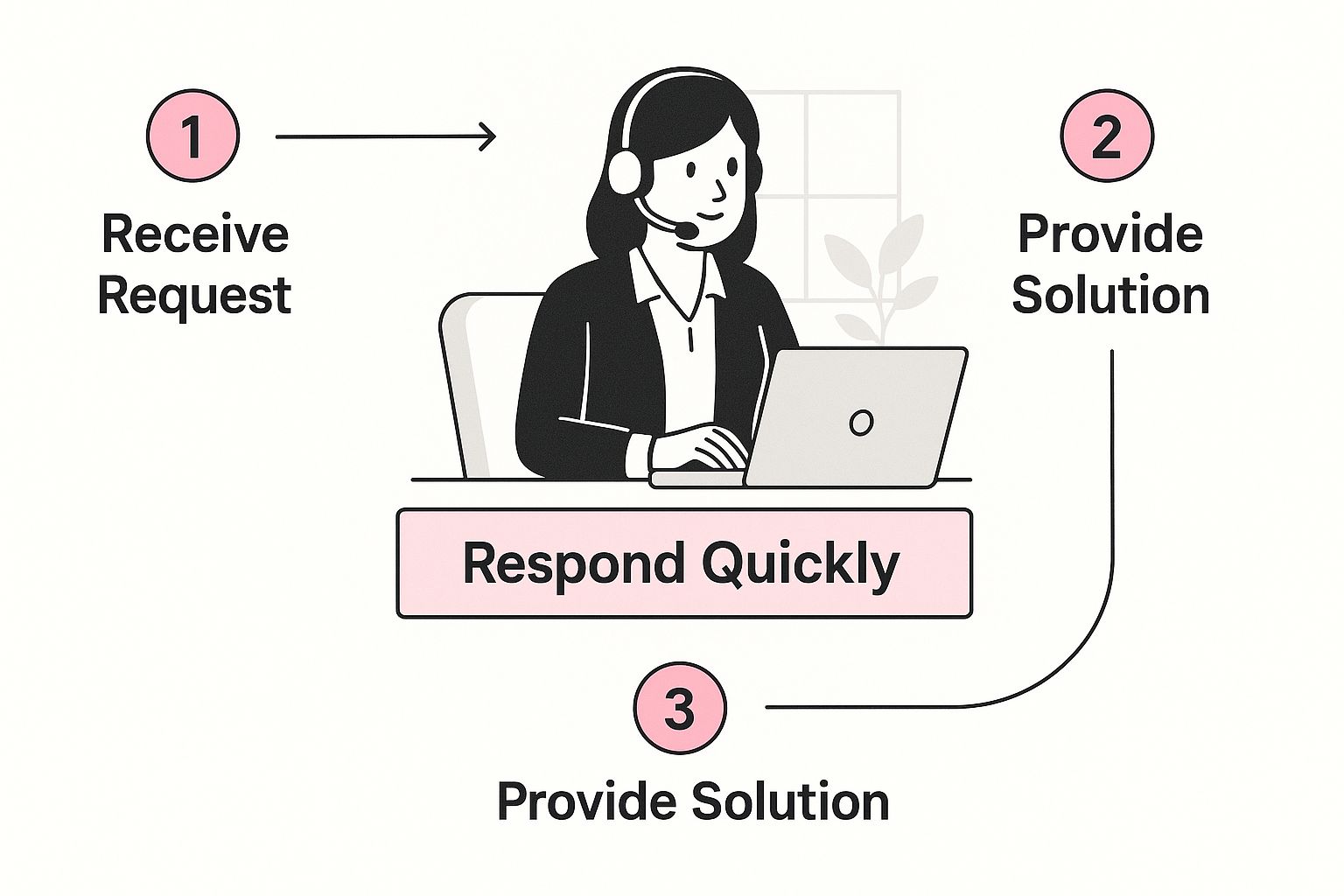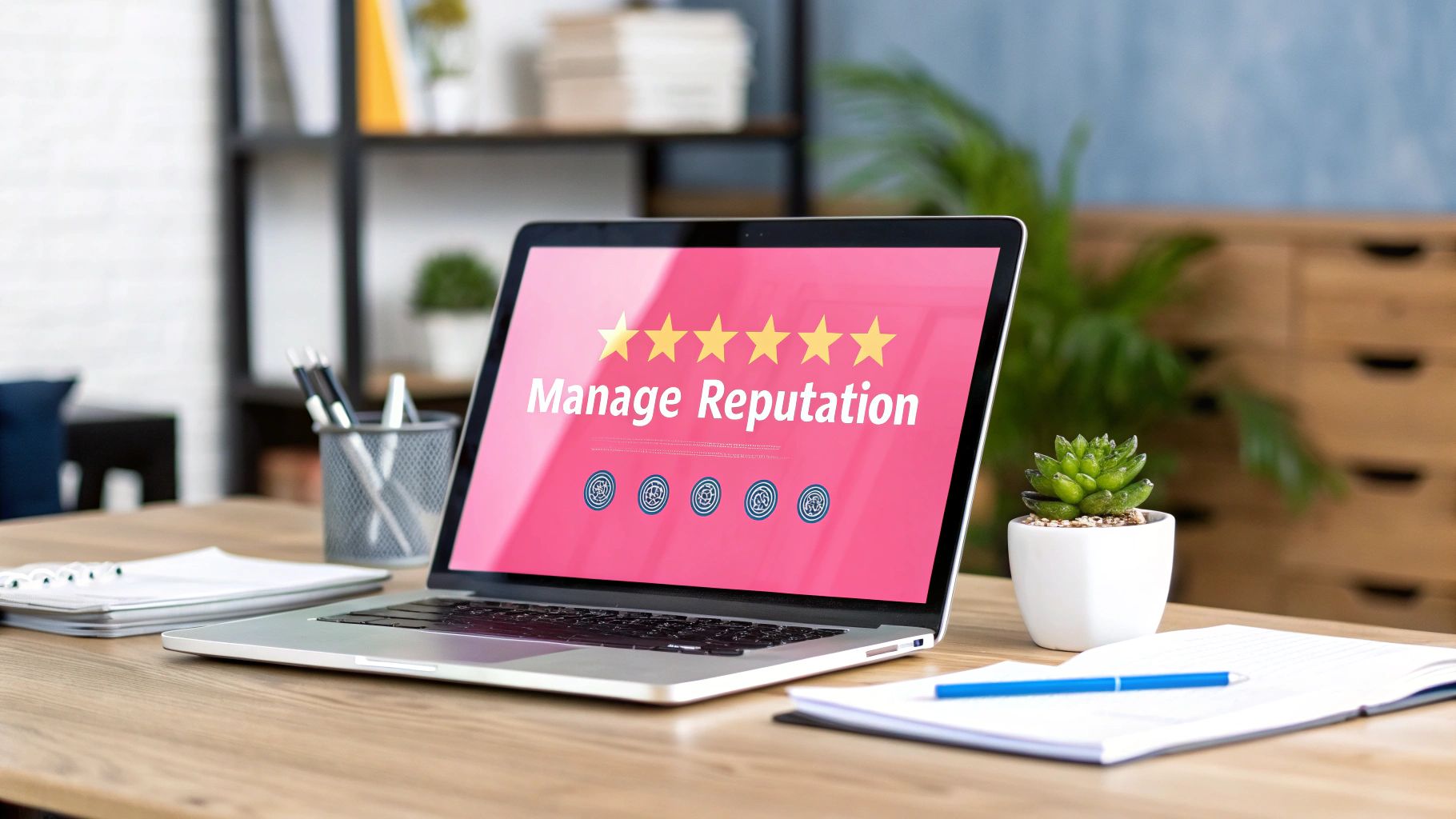Table of contents
To get a real handle on your online reputation, you need to be doing three things consistently: listening to online chatter, jumping into conversations with your customers, and actively encouraging positive feedback. This means keeping an eye on mentions everywhere from Google to social media, making sure you reply to all feedback (good and bad), and having a simple way for happy customers to sing your praises. It's a mix of building goodwill and being ready to react.
Why Your Online Reputation Is a Critical Asset in Australia
In Australia, your online reputation isn't just some background noise anymore; it’s a genuine business asset you can feel in your bank account. The way people see your brand is now decided on their screens. This is where trust is built, meaning every single review, comment, and star rating directly impacts whether you get new customers, attract top talent, or even grow at all.
Think of a solid reputation as your best salesperson, one that never sleeps. It's out there 24/7, building credibility and giving potential customers the social proof they absolutely need before they'll even think about buying. On the flip side, a neglected or damaged reputation is like a financial anchor, actively scaring away customers before they ever land on your website.
The Power of the Customer Voice
The sway that online reviews hold over Aussie consumers is massive. Get this: 85% of consumers now trust online reviews just as much as a recommendation from a mate or family member. That statistic alone shows just how much the game has changed.
But it gets even more serious. A whopping 92% of Australian consumers will only even consider using a business if it has at least a four-star rating. That means one bad review isn't just a minor blip; it could be costing you a stream of potential customers.
This reality shifts reputation management from a "nice-to-have" PR task to a core business function. It’s not just about cleaning up messes; it’s about building a resilient brand that can take a hit, learn from it, and use the good stuff to fuel growth.
Your reputation is built on a few core pillars. Focusing on these areas ensures you're covering all your bases, from what people say about you to how you present yourself.
Here's a quick look at the essential components every business needs to manage:
The Core Pillars of Modern Reputation Management
By consistently working on these four areas, you create a robust system that not only protects your brand but actively enhances it.
More Than Just Reviews
While reviews are definitely the cornerstone, a truly effective reputation strategy goes much deeper. It covers your entire digital footprint, from how you chat with followers on Instagram to the blog posts you publish. It's also about being prepared for the unexpected. Smart online reputation management includes having a solid plan for when things go wrong, which means a comprehensive approach to social media crisis management.
A proactive approach to reputation management is really about controlling your own story. Instead of letting random, unmanaged comments define who you are, you get to shape that perception yourself by playing to your strengths and owning your weaknesses.
At the end of the day, a well-managed reputation gives you a serious edge over the competition. If you're ready to get into the nitty-gritty of the strategies and tools you can use, have a look at our complete online reputation management guide. It’s packed with actionable steps to help you build and protect your brand's image.
Setting Up Your Digital Listening Posts
 You can't manage what you don't monitor. To get a real handle on your online reputation, you first need to know what people are saying about you, where they're saying it, and when. This means setting up a network of digital "listening posts" to catch mentions from all corners of the web.
You can't manage what you don't monitor. To get a real handle on your online reputation, you first need to know what people are saying about you, where they're saying it, and when. This means setting up a network of digital "listening posts" to catch mentions from all corners of the web.
Relying on a casual Google search of your business name every now and then just won’t cut it. Conversations about your brand are happening in so many places, from the big-name review sites to tiny, niche online communities.
Putting a proper listening strategy in place is like having an early-warning system. It helps you spot problems before they blow up and jump on opportunities to thank happy customers.
Start with the Free and Essential Tools
Before you even think about splashing cash on paid software, you can build a surprisingly effective monitoring system with tools that won't cost you a cent. The aim is to cast a wide net that catches mentions of your business name, your key people, and even specific product or service names.
The most obvious place to start is Google Alerts. It's a simple but genuinely powerful service that drops an email in your inbox whenever it finds new web pages, news articles, or blog posts that mention your keywords. It’s the absolute baseline for any reputation monitoring.
Setting it up is a breeze:
- Head over to the Google Alerts website.
- Pop in your business name. I recommend using quotation marks, like "Your Business Name", to get exact matches.
- Create separate alerts for common misspellings, key staff members, and any unique product names.
- Set the frequency to "As-it-happens" for real-time notifications.
This simple setup means you're immediately in the loop when Google indexes a new mention, giving you a crucial head start on figuring out your response.
Expanding Your Monitoring Horizons
Google Alerts is great for the wider web, but a lot of the really important chatter happens on specific platforms that need a bit more direct attention. For Australian businesses, some sites definitely carry more weight than others.
Think of it like this: if your business were a physical shop, you wouldn't just listen for gossip on the main street. You'd also pay attention to what's being said in the local community hall and the nearby cafe. Digital listening posts work the same way.
You need to be actively keeping an eye on the platforms where your customers actually hang out. For an Aussie business, that almost always includes:
- ProductReview.com.au: A massive player in the local review scene that you can't ignore.
- Industry-Specific Forums: If you're a mortgage broker, this might be a property investment forum like PropertyChat.
- Local Facebook Groups: These community hubs are often where spontaneous recommendations and complaints first pop up.
- Social Media Platforms: This includes X (formerly Twitter), Instagram, and LinkedIn where conversations move fast.
To really get a grip on these online conversations and see the impact of your efforts, using a comprehensive social media analytics dashboard can centralise your tracking and give you much deeper insights. These tools pull in mentions and sentiment from all over, saving you from the tedious task of checking every single platform manually.
For most small businesses, a combination of free tools and a disciplined daily check-in is a fantastic starting point. I've found that blocking out just 15 minutes each day to scan these key channels is enough to stay on top of the conversation. As your business grows and the volume of mentions picks up, investing in a paid monitoring tool becomes the logical next step to automate the whole process and manage your online reputation at scale.
Building a Proactive Review Generation Machine
A fantastic reputation isn’t built by sitting back and hoping for the best; it’s forged from a steady, authentic stream of customer praise. It’s time to shift from passively waiting for good reviews to actively building a system that encourages them.
This isn't about being pushy or annoying. It's about making it incredibly simple for your happy customers to share their positive experiences when they're most willing to do so.
Think about the peak of customer satisfaction. For a car detailer, that magic moment is the big reveal of a gleaming, showroom-quality car. For a mortgage broker, it might be a week after the loan has settled and the client is happily unpacking in their new home. The key is to time your request when the value you’ve delivered is fresh and exciting in their mind.
Making the Ask Effortless
Your customers are busy people. If leaving a review feels like a chore, it won't happen. A long, complicated survey will get ignored almost every time. Instead, your focus should be on simple, direct methods that actually get results.
From my experience, these strategies work time and time again:
- Personalised Email Requests: A simple, warm email that thanks them by name and includes a direct link to your preferred review platform (like your Google Business Profile) is a classic for a reason.
- Targeted SMS Messages: Don't underestimate the power of a quick text. A friendly message with a link can have a surprisingly high open rate, making it perfect for customers on the go.
- Simple Instructions: Never assume everyone knows how to leave a review. Briefly explain the one or two steps required. The easier you make it, the more likely they are to follow through.
If you're looking for some great templates and best practices, it's worth exploring specific strategies for how to get more Google reviews.
The Critical Need for Authentic Reviews
Building this review machine isn't just a smart marketing move; for Australian businesses, it's a legal and ethical necessity. The temptation to cut corners with fake reviews is real, but so are the consequences. Regulators are cracking down hard on disingenuous feedback.
This infographic hammers home how quickly a business must act to maintain a positive relationship with customers—a key part of earning authentic reviews in the first place.

This sense of urgency has become even more critical lately. The rise of artificial intelligence has led to an absolutely staggering 758% increase in AI-generated reviews on major platforms. In response, Australian and global regulators are moving to ban fake and AI-generated reviews, demanding far greater transparency from businesses.
Your goal should be to create a culture of feedback where authentic praise becomes a natural byproduct of excellent service. Every genuine five-star review you earn is a powerful asset that insulates your brand against criticism and builds unshakable trust.
By prioritising genuine interactions and making it dead simple for customers to share their stories, you can effectively manage your online reputation and turn it into one of your most powerful drivers for growth. It's a proactive approach that ensures your brand's integrity remains completely intact.
Mastering the Art of Responding to Reviews

This is where the rubber meets the road. How you handle customer feedback—the good, the bad, and the ugly—is where your reputation is really built. A quick "thanks for the review" just doesn't cut it anymore. Think of your replies as a public performance, showing everyone watching just how much you care and giving you a chance to spin feedback into a powerful marketing asset.
Responding to every single review, positive or not, should be non-negotiable. With over 77.9% of Australians active on social media and a whopping 97.1% online in general, real-time engagement is an expectation, not a nice-to-have. That high level of connectivity means your responses are seen by a massive audience, making them a crucial piece of the puzzle to manage your online reputation.
Amplifying Your Positive Reviews
When a customer leaves a glowing review, it's a gift. Your job is to make that gift work harder for you. Ditch the robotic, templated replies and get personal. The key is to mention a specific detail from their feedback to show you’ve actually read it and appreciate their time.
Imagine a car detailer gets this review: "They made my 10-year-old car look brand new, especially the interior!"
A fantastic response would be:
"Thanks so much for the kind words! We're thrilled you loved the interior detail—that's our favourite part of the transformation too. It was a pleasure getting your car back to its best, and we look forward to seeing you again!"
This kind of reply hits all the right notes:
- It’s personal and specific, proving there’s a real human on the other end.
- It subtly reinforces your strengths (in this case, interior detailing).
- It encourages repeat business by ending on a warm, forward-looking note.
A Framework for Handling Negative Feedback
Negative reviews are tough. No one likes getting them. But they’re also a golden opportunity. A thoughtful, calm, and public response can often do more for your reputation than a dozen five-star reviews. It shows you're accountable and genuinely committed to getting it right.
Your first move should never be to get defensive. Acknowledge their frustration, apologise that their experience didn’t meet expectations, and offer to make things right.
A great response framework is to Acknowledge, Apologise, and Act. Acknowledge their specific issue, apologise for the experience, and then clearly state the action you’ll take to resolve it.
Here’s a practical game plan for when criticism pops up:
- Respond Promptly, but Not Instantly: A quick reply shows you're on the ball, but give yourself a minute. Step away, cool off, and then craft a professional response.
- Take It Offline: After your initial public reply, always offer to sort out the specifics privately. Provide a direct email or phone number. This moves a potentially heated back-and-forth out of the public spotlight.
- Learn from the Feedback: Treat the criticism as a free diagnostic tool. Is there a recurring problem in your process that needs fixing? Use it to get better.
Responding well can be tricky, but there are proven ways to de-escalate the situation and resolve the issue. For a deeper dive, our guide on how to respond to negative reviews offers detailed templates and strategies. By handling criticism with grace, you show integrity and can often turn an unhappy customer into one of your biggest supporters.
Using Social Media to Build Your Reputation
Social media can be a minefield. Get it right, and you've got a powerful channel for shaping how people see your brand and for building a real community. Get it wrong, and it can become a serious liability, fast. Your social channels are so much more than a place to run ads; they're the front line where your brand's personality and values are on full display.
Think of it this way: every single post, every reply, every story you share is a puzzle piece in the public’s perception of your business. The trick is to create content that feels genuine and truly reflects what your brand is all about. This kind of consistency is what builds trust and gives people a reason to follow you—not just for what you sell, but for who you are.
Content That Actually Connects and Engages
If you want to genuinely manage your online reputation on social media, your content has to do more than just shout about your products. It needs to spark a connection. That means creating posts that invite people into a conversation, sharing behind-the-scenes moments, and giving your audience something of real value.
What does that look like in practice? A mortgage broker could share practical tips for first-home buyers navigating the market. A car detailer might post a deeply satisfying time-lapse video of a full detail. The goal isn't to be a billboard; it's to become a go-to resource.
Here are a few content ideas I’ve seen work wonders for building community:
- Showcase Your Team: Putting a face to the name makes your business feel more human and approachable. People connect with people.
- Share Customer Stories: Don't just keep great testimonials on a hidden page. Turn them into compelling posts that offer undeniable social proof.
- Ask Questions and Run Polls: Get your audience directly involved. Making people feel heard is one of the quickest ways to build loyalty.
Of course, creating great content is only half the battle. You also need to be ready for when things don't go to plan. Having a solid social media crisis management guide in your back pocket can be a lifesaver, helping you handle unexpected negative feedback and protect your hard-earned reputation.
Navigating Influencer Marketing in Australia
Collaborating with influencers can be a brilliant way to build credibility, but it's a path littered with risks if you're not careful. The influencer marketing scene in Australia is exploding, with spending projected to soar to AU$943.8 million in the next year.
This rapid growth hasn't gone unnoticed by regulators. A recent ACCC review was a real eye-opener, finding that a staggering 81% of influencers had posted ads that were potentially misleading. That’s a massive risk for any brand. An undisclosed or inauthentic partnership isn’t just a bad look—it can shatter your credibility.
I’ve consistently found that micro-influencers often deliver better results. Their smaller, more niche audiences tend to have much higher engagement and trust, making their endorsements feel more like a genuine recommendation from a friend than a paid advertisement.
To keep your brand safe, you have to be completely transparent. Any and all sponsored content must be clearly labelled with tags like #Ad or #Sponsored. This isn't just a suggestion; it's a legal requirement under Australian Consumer Law. By choosing partners who are a genuine fit for your brand and insisting on crystal-clear disclosure, you can use influencer marketing to boost your reputation, not put it in jeopardy.
Burning Questions? We’ve Got Answers.
Here are some of the most common questions we hear from Australian business owners just starting to get a handle on their online reputation. Let's clear up the confusion so you can move forward with confidence.
Can I Legally Zap a Negative Review in Australia?
This is a big one, and the short answer is usually no—not if the review is a genuine expression of a customer's experience. You can't just delete a review because it stings or you disagree with it.
However, you absolutely have the right to request its removal if the review breaks the rules of the platform. Think content that is:
- Abusive or contains hate speech.
- Clearly spam or written by a fake profile.
- Defamatory or leaks someone's private information.
If you believe a review crosses the legal line into defamation, your best bet is to chat with a legal professional. But for the vast majority of negative feedback, your most powerful tool is a calm, professional response that aims to solve the customer's problem.
Remember, your best defence against a negative review is a strong offence of positive ones. A single bad review has far less impact when it's just one drop in a sea of glowing testimonials.
What’s a Realistic Budget for a Small Business to Manage Its Reputation?
Getting started doesn't need to break the bank. For a small business, you can make a huge impact with a minimal cash outlay by using free tools and dedicating a bit of time to the process.
Honestly, your initial investment is more about time and creating a solid system than it is about money. You can achieve a ton just by setting up free Google Alerts to monitor mentions and making a commitment to reply to every single review.
As your business grows and the chatter gets louder, you might look at paid monitoring software, which can start from around $100 per month. But don't let budget be the reason you do nothing; the most important first steps won't cost you a cent.
What's the Single Most Important Thing I Can Do Today?
If you do just one thing after reading this, make it this: claim and completely fill out your Google Business Profile. This is your digital front door—often the very first impression a potential customer has of your business. Make it a good one.
Check that every detail is correct, upload some recent, high-quality photos of your work or your shop, and start responding to every review you have. Yes, all of them—the good, the bad, and the so-so. This one move immediately signals that you're in business, you're engaged, and you care about your customers. It’s the foundational step to truly manage your online reputation.
Ready to put your reviews on autopilot? Testimonial Donut simplifies the entire process, from sending smart requests to showcasing your best feedback. See how easy it can be to build a five-star reputation at https://www.testimonialdonut.com.



